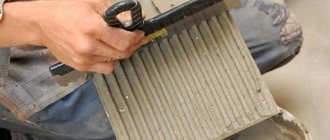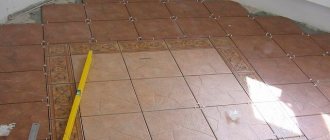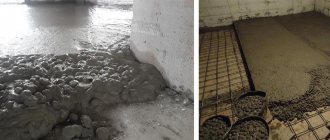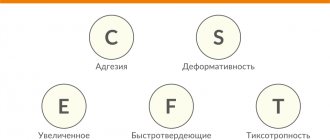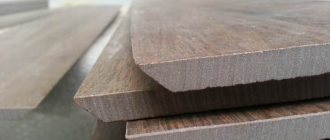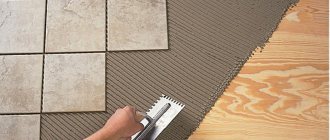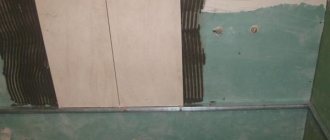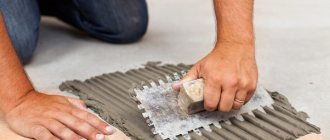Are there many finishing materials that are beautiful, resistant to water, frost, heat, temperature changes, resistant to mechanical stress, non-fading, and easy to care for? I think not so much. One of them is porcelain stoneware. This combination of qualities contributes to the high popularity of the material - it is used in exterior and interior decoration. A complex system of external fastening does not make it possible to do this yourself, but laying porcelain stoneware on the floor or walls indoors is a task of average complexity and can be done with your own hands, without the involvement of specialists.
Beautiful, solid, reliable
Calculation of the number of tiles
To determine the required amount of cladding, you should take into account the layout pattern and the width of the seams:
- In corridors, hallways and other rooms with a minimum of furniture (or without it), the size of the cut tiles is more than ½ of its original size.
- If there is furniture in the room and plumbing fixtures in the bathrooms, it is necessary to take into account the visible part of the floor. Near walls, the size of the trim does not matter.
- If opposite walls are not perfectly parallel to each other, then thanks to diagonal laying this defect can be hidden. However, in this case you will have to spend more finishing material and increase the amount of trimming.
- If only 1 day is allotted for work, finishing begins from the far corner and moves towards the door opening.
- If the screed is absolutely flat, the porcelain tiles are laid out dry. After pruning, entire rows are laid.
- Continuous seams are needed when several rooms are tiled.
- If one room is being clad, then the joint should be located in the middle of the door opening - under the threshold or the lower element of the interior door frame.
- An elongated rectangular porcelain tile, similar to a parquet board, should be laid perpendicular to the wall that has a window opening. As a result, the flow of sunlight will fall along the seams.
The “seam to seam” layout and the displacement of transverse seams requires the following procedure for calculating the amount of porcelain stoneware:
- The length of the wall must be divided by the size of the tile, including the width of the joint. The same is done for calculating the second wall.
- Both values should be rounded up and multiplied.
Seamless styling
To make the picture perfect, you will need to follow a number of rules. First of all, purchase material from one batch, with a large excess. If suddenly there is not enough, it will be impossible to purchase another one, because the TKR may already be different. Now, with the help of special programs, cutting and laying schemes are developed. The fragments are cut on a cutting machine with a special diamond cutter.
Now the final touch: you need to lay out the entire picture on the prepared surface, after which all the parts are numbered in the order of final laying. The first time this is done dry, without glue. Final adjustments and sanding are carried out if required. In compliance with the resulting diagram, the parts are laid out on glue. Having done this work, you can get a beautiful floor.
Options and installation methods
There are several ways to lay out porcelain stoneware - diagonally, butt to butt, herringbone, mosaic, and also staggered like brickwork.
After this, it is necessary to determine the presence and width of the seams. Large porcelain tiles are most often installed in a seamless manner in the toilet or bathroom. In other rooms, the width of the seams is up to 5 mm with the installation of crosses.
After this, you need to select a technology for controlling the plane of the coating being created. Installation of the first tile is carried out horizontally in two directions at right angles to each other. You can then use the following methods:
- use of the SVP system;
- application of the short 1 m rule;
- checking the level of all subsequent tiles.
The standard installation method is as follows: on the first day, you need to fill the space of the base of the floor with a solid element, and on the second, cut and glue pieces of porcelain stoneware. If the amount of work is minimal, then pruning can be done for each row.
Photo examples of finishing premises with porcelain stoneware
Kitchen apron - convenient, beautiful, reliable
An interesting way of laying with an offset
Finally, wood can be in the bathroom too, albeit made of ceramics
Chic bathroom interior using polished porcelain tiles
Practical kitchen floor
Interesting collection for walls
A staircase with laid porcelain tiles will be beautiful, comfortable, and easy to care for.
Variations on the theme of natural stone in the bathroom
Wide contrasting seams are a design element
Choosing a tile
Today there is no shortage of choice of porcelain tiles: there are many options in stores that differ in color, structure, and purpose. There are several types of tiles.
Technical
Such tiles are not used for interior decoration of residential premises due to their specific appearance. Its main qualities are high wear resistance and strength.
Polished
Polished tiles have an ideal mirror shine, which is achieved by the fact that manufacturers, along with polishing the surface, cover it with a special varnish. However, such tiles are characterized by an increased risk of injury.
Matte
Matte tiles are not polished, so they have a lower cost and increased strength, as a result of which they receive a number of advantages over polished products.
Structured
Such tiles are similar in appearance to the structure of wood, leather and other materials.
Lapped
This tile is polished, but not completely, so there are both polished and matte areas on its surface. Designed to implement unusual design solutions.
Glazed
These tiles are coated with colored glaze. The product looks beautiful, but is subject to rapid chipping and abrasion. It is better to glue tiles where there are no increased mechanical stress.
Satin
To produce satin tiles, mineral salts and wax are used. Similar products shine, but only a few.
Getting to know the material
Blanks are made from special mixtures, which are pressed and then fired. As a result of these processes, porcelain stoneware is obtained. It consists of clay, quartz sand, as well as water and spar. Sometimes dyes are added to create a specific appearance.
The positive qualities of porcelain stoneware include the following characteristics:
- High moisture resistance. This quality allows it to be used when finishing rooms with high humidity, as well as for exterior decoration.
- Also, this material is not afraid of exposure to chemicals. It can be used in chemical fertilizer warehouses or in various laboratories.
- Temperature changes also do not affect porcelain stoneware.
- The material has a rather aesthetic appearance. In addition, it does not fade in the sun and does not wear out.
All these qualities make this finish reliable and durable.
Preparing the base for laying porcelain stoneware
To apply adhesive to the base and tiles, use a notched trowel, which is positioned at right angles to its surface. If the concrete screed is perfectly leveled, then laying and leveling is much easier.
It is not advisable to level the base with tile adhesive - it is difficult and requires a lot of time and money.
To prepare the base of the floor for finishing with cream granite, it is necessary to cover it with a layer of deep penetration primer. As a result, the consumption of glue and the absorption of moisture from it by the screed will decrease, adhesion will increase, and the coated surface will last a long time.
At the same time, at the same step, the installation of TP elements takes place - water pipes, film mats, SIP cable.
Surface preparation
Cladding must be preceded by compliance with certain requirements for the surface to be laid.
- Durability
Concrete or cement-sand screed needs time to stabilize. Ignoring this point will lead to the appearance of cracks in the structure, as a result of which the porcelain stoneware will peel off. Each centimeter of screed made in the traditional way requires 7–10 days to fully set. The cement gains full strength after 28 days. Using special additives, you can reduce this period. - No cracks
If cracks occur, they should be filled with an elastic mixture. Alternatively, epoxy resins and strong adhesives are suitable.
- Purity
The base must be clean. Rust, paint, grease, and oils interfere with adhesion, so their presence is incompatible with high-quality cladding.
- Base strength
The structure and thickness of the screed must correspond to the conditions of use. The parameters depend on the nature of the rough base, the temperature conditions and the load resulting from the cladding.
- Plane
The surface does not have to be horizontal (depending on the purpose of the room, a slope is possible), but must be flat. Unplanned changes in height, holes and bumps increase the consumption of glue and the period of cladding.
- Padding
The concrete base needs to be impregnated with a special primer, which promotes additional adhesion of the microcomponents. Cement screed requires deep penetration of the composition, drywall needs superficial penetration.
- Waterproofing
When tiling a room in which increased use of water is planned (kitchen, bathroom, etc.), the floor should be waterproofed. It will prevent the destruction of the foundation and possible flooding of the lower floors.
Repairing cracks in screed
Glue selection
If you choose the right adhesive composition for a specific facing material, the coating will last a long time, be strong and reliable. When porcelain tile imitates a natural base, it not only looks beautiful, but is also especially durable. At the same time, its ability to withstand heavy loads is affected by installation, which in turn depends on the selected adhesive mixture.
For each facing material, it is important to choose the right adhesive composition, which will ensure the reliability and durability of the coating. Porcelain tiles that imitate a natural base are distinguished not only by improved aesthetics, but also by increased durability. However, its ability to withstand loads depends on its installation, where the type of adhesive mixture used is key.
Characteristics of mixtures
According to the EN 12004 and EN 12002 standards, adhesives developed for laying tiles are divided into several types depending on their characteristics and chemical properties. composition:
- cement (C);
- reactive (R);
- dispersive (D).
Cement adhesives are especially common - they are universal and suitable for most cases. Reactive compositions based on epoxy resin are characterized by increased adhesion. They are used to glue ceramics with complex compounds, such as wood or metal. When facing a concrete base, it is not advisable to use them due to their high cost. Also, dispersion adhesives are not suitable for concrete bases - they are unable to penetrate deeply into the surface, despite increased adhesion. At the same time, this feature is appreciated when laying the inflow on drywall.
There are several classes into which each type of adhesive composition is divided:
- basic (1):
- improved (2):
- fast setting (F);
- long-setting (E);
- elastic (S1);
- super elastic (S2);
- vertical slip resistant (T).
Tips for choosing a mixture
The quality of the cladding depends on the correct choice of glue. To select a specific composition, it is necessary to take into account the following features:
- What structure does the base have? If the structure is non-standard - old tiles, waterproofing, wood, drywall, standard - plaster, cement screed.
- What tile format? If the tile is large in size, then the glue must have high adhesion.
- What kind of surface the tiles are used on (wall surface, floor surface), and whether they are used inside or outside the building.
- Time period before putting the premises into operation. If time is short or temperatures are minimal, then quick-setting C2F glue is optimal (MAPEI GRANIRAPID is suitable).
- Weather during work.
Working with glue
Due to the near-zero water absorption of porcelain stoneware, certain requirements are put forward for the application of the adhesive composition. So, with standard ceramics, it is enough to coat the surface of the base once. To install porcelain stoneware with a higher quality, it is necessary to apply it on both sides - on the tile and on the screed (or plaster). As a result, no empty spaces are formed under the ceramics, and excellent adhesion will be achieved. When empty spaces appear on the cladding due to impact or increased point load, cracks may occur. There is also a risk of moisture forming in them and further freezing.
When applying glue, use a smooth metal spatula. Remains of glue must be removed with a notched trowel. The dimensions of porcelain stoneware affect the size of the teeth and the type of tool. On the back side of the tile, a thin coating of the mixture will suffice. The main thing is to ensure a strong connection between the glue and the mounting base.
If floor installation is carried out inside a living room, then the connection between the adhesive and the mounting tile side is at least 70% of the total surface. If the tiles are laid in non-residential premises, as well as outside buildings, it is necessary to achieve 100% application of adhesive on both surfaces.
What to look for when choosing
When choosing porcelain tiles, you need to pay attention not only to appearance, but also to quality. Before making a purchase, first inspect several samples, preferably from different packs. By external signs you can tell with a high degree of certainty how high-quality the material is.
- Measure the dimensions of the tile. They may differ by several millimeters from those stated. If you are not going to combine them with porcelain tiles of a different size, this may not be a problem, but you need to be aware of it. It’s worse if the tiles from different packs are of different sizes - laying porcelain tiles will turn into a difficult task. It is better to refuse such material.
- Look at the end of the porcelain tile. If it is not a structured or satin variety, the side surface should look the same as the front surface.
In addition to appearance, we pay attention to geometry - Inspect the back. Diamonds or squares should be formed here. The optimal cell size is 1.5-2 cm, the protrusion height is 2-3 mm. If the squares are more than 3 cm or larger, and the projections are high, you have low quality porcelain tiles.
- When purchasing, check the geometric shapes of several tiles taken from different boxes. Measure several tiles. Ideally, there should be no difference in size. Also check whether the edges are smooth, whether the surface is curved/concave, or whether there is a “propeller”.
If all tests are successful, porcelain tiles can be taken. But there are a few more points. Make sure that all packs are the same size and thickness. Take out the tiles and compare shades. Often there are quite noticeable differences, which then catch the eye when laying porcelain stoneware.
Required Tools
The tools we need to lay porcelain tiles on the floor:
- container for preparing the solution - usually a plastic bucket 15-20 l;
- trowel or spatula - for laying the adhesive mixture;
- notched spatula - for uniform distribution of glue;
- mixer or attachment for a drill/hammer – for stirring the glue;
- roller, brush - for applying primer;
- level – for horizontal control;
- crosses - to create seams of the required size;
- tile cutter - manual, electric or angle grinder (“grinder”) with a diamond blade;
- primer;
- tile adhesive - any domestic/foreign brand.
After you have purchased the tools for installation work, you should ensure that you have the following tools for finishing:
- Wedges. Another name is the tile leveling system (SVP).
- Crosses. Designed to ensure equally even seams.
By choosing the thickness of the crosses wisely, you will achieve excellent quality flooring. The thickness of porcelain stoneware, which ranges from 3 to 30 mm, should also be taken into account. The thickness of the material for laying tiles on the flooring in an apartment is 4-8 mm. For wall cladding and flooring in public high-traffic areas and building facades, products with increased strength are needed.
Expansion joints
Scheme of floor covering with expansion joints.
To compensate for the deformation of building elements and to avoid damage to the coating, expansion joints are installed in concrete floors. They are divided into three types.
- Perimeter
They are arranged along the contour of walls and columns in order to limit the influence of deformation of structural elements on the screed. To do this, a strip of compressible material, usually 1 cm thick polystyrene foam, is laid around the entire perimeter of the room before pouring the screed.
- Temperature
The screed inevitably cracks during use. To limit the appearance of cracks, expansion joints are installed. It is recommended to cut into squares, but in any case the width should not be less than one and a half times the length. The usual size of squares is 6x6 m.
- Separating
Needed to limit mechanical loads associated with rapid evaporation of moisture in the first half of the year of concrete operation. Performed on an area of up to 30% of the screed. The width of the gaps is usually at least 5 mm.
The last 2 types of expansion joints are used mainly in large commercial premises, or with an area of more than 25 m². For external coverings, at least every 9-12 m².
How to lay porcelain tiles on the floor: all the steps
Installation of porcelain tiles on the floor consists of 5 steps:
- First, glue is applied in the center of the room, which should be spread over the surface using a notched trowel. If the tile is thick, then there should be more glue - but up to a maximum of 5 mm.
- The next step is laying porcelain tiles and tapping the products with a rubber hammer. Separating crosses must be placed between them.
- The glue that comes out through the joints is removed with a sponge or soft cloth. Within an hour after laying the tiles, they will shrink, so they may become lower.
- When laying tiles next to walls, it is necessary to trim porcelain tiles.
- After the work is completed, the glue will dry within 24 hours. After this, you need to prepare the grout and process the seams. To fill the grooves and remove excess mixture, use a rubber spatula. After the grout has dried, remove excess grout with a sponge or damp cloth.
Rectified
Edged porcelain tiles differ from similar ceramic products in silhouette and caliber. Rectification makes it possible to obtain defect-free tiles with impeccable straightness of the contour; edges are trimmed using special equipment or using abrasives and water.
Floor painting - painting technology for wooden and concrete floors (80 photos)- Marmoleum - installation basics and rules for laying natural linoleum (70 photos)
Cork flooring - features of coating application and installation rules (100 photos)
Rectified allows for seamless installation; it is not recommended to use such a monolithic coating for rooms with heated floors or places where temperature changes are constantly observed.
Rules for laying porcelain tiles on a heated floor
Laying porcelain stoneware on a heated floor is standard, but at the same time it has a number of features.
Make sure the heating system is working properly. When heating with water, the pipes should be covered with a cement screed, but with an electric screed, it is not necessary - the material can be laid on a rubber backing.
The adhesive layer affects the heating of the surface. If the layer is thick, then the heating decreases. The same is true for the thickness of porcelain tiles.
When spreading the glue over the surface, do not damage the heating elements. Do not turn on the heating until the glue and grout are completely dry. After the installation work is completed, gradually increase the temperature - if it increases sharply, cracks may appear under the coating.
To ensure good thermal conductivity of the floor, leave a distance of 2 mm in the seams.
Hackwork or quality work
In fact, you can find craftsmen of any level on the market. That is why the quality of the delivered object will vary greatly. Some people claim that seamless installation is a technology for reducing them, using good grout, matched to the color. At first it will look like a truly monolithic picture.
However, there really is a way to lay porcelain stoneware without seams. Butt-joint technology is popular today, it’s really very beautiful. At the same time, a master who takes on this for the first time is doomed to failure. With a cutting accuracy of +/- 5 mm in a room 3 meters wide, the discrepancy can be up to 2.5 mm. Of course, it can be hidden by moving the seam along the rows. But there will be a gap near the wall, covered with baseboards.
Laying porcelain tiles on a wooden floor
It is also possible to lay porcelain tiles on a wooden surface, the main thing is preparation and study of the specifics of the work.
First of all, it is necessary to install wooden logs on the surface, which should already be treated with antiseptic agents. To prevent bending, a gap of 15-20 cm should be left between them.
Next, pour expanded clay between the lags to the top, and then cover the structure with a board and secure it using self-tapping screws. To prevent moisture from the glue from saturating the wood, waterproofing materials are needed. If the wood becomes saturated with moisture, this will lead to its deformation and deterioration in the quality of the coating.
Next, choose one of two styling methods.
- Attach a metal mesh to the treated wooden base using self-tapping screws. Place the beacons and fill them with cement screed - this will become the basis for subsequent installation.
- Use a dry screed: lay multi-layer moisture-resistant plasterboard over the waterproofing. Secure it and start laying tiles. The main thing is to choose an adhesive whose properties are suitable for this material.
Craftsmen often argue about whether laying porcelain stoneware on plywood is acceptable. If you follow the rules and work techniques, complications will not appear. First, you need to install the logs at a minimum distance from each other, and then fix a plywood sheet with a thickness of 3 cm on them. Carefully fix the plywood on the logs, remove debris and sand the seams (when there are several sheets).
Cover the plywood with two layers of primer, wait until it is completely dry and begin installation work. In such a situation, an adhesive designed for installing parquet is optimal.
TOP 3 porcelain stoneware manufacturers
| Photo | Name | Rating | Price | |
| #1 | Kerama Marazzi | ⭐ 98 / 100 | More details | |
| #2 | Italon | ⭐ 97 / 100 | More details | |
| #3 | Estima | ⭐ 96 / 100 | More details |
Estima
Estima porcelain tiles (Russia) are produced on modern, latest generation machines in this field, equipment supplied by leading Italian manufacturers
pros
- high wear resistance;
- waterproof;
- the material is fade resistant;
- long service life;
- Can be installed in any room or outdoor area.
Minuses
- bad calibration.
Estima porcelain stoneware
Italon
Italon produces exceptionally high quality porcelain tiles - a product unique in its aesthetic and technical characteristics, as well as in functionality.
pros
- moisture resistance and water resistance;
- the material is frost-resistant;
- long service life;
- resistant to mechanical and shock loads;
- a wide range of.
Minuses
- insufficient wear resistance of the top layer;
- high price.
Italon porcelain tiles
Kerama Marazzi
Kerama Marazzi is a domestic manufacturer that has firmly occupied a leading position for several years in a row. Kerama Marazzi ceramic granite is an innovative, more advanced generation of ceramic tiles.
pros
- good quality;
- wide selection of different textures;
- long service life;
- wear-resistant;
- high strength of the product;
- environmental friendliness and safety.
Minuses
- geometry mismatch.
porcelain tile Kerama Marazzi
Cutting and processing of porcelain stoneware
Porcelain stoneware is fired in a kiln 2 times at elevated temperatures. There is a hardened layer inside it, so standard cutting of the material becomes more complicated. Thus, when cutting a line with a roller casting cutter, the corners often break off. The size of the floor cladding is large, so a situation may arise in which it does not fit into the tile cutter.
For this reason, other cutting options are optimal:
- angle grinders;
- mobile dry electric tile cutter;
- professional “wet” network tile cutter (an expensive tool).
There may be external corners on the floor, which usually appear at the junctions with the balcony steps. Most often, cutting the edges of two facing elements at an angle of 45 degrees is used.
The grinder requires a separate device. Dry and wet type machines often include angular cutting. Read more about cutting porcelain tiles in our article Methods for cutting porcelain tiles
Application options
Due to its highest strength, porcelain stoneware is suitable for finishing:
- building facades;
- walls and floors in commercial premises (offices, shopping centers, cultural centers);
- walls and floors in living spaces.
Porcelain stoneware has no equal when it comes to façade cladding: it looks stylish, is easy to install, is not afraid of heat and frost, does not burn in fire, does not swell in the rain, and is easy to clean. Porcelain stoneware slabs are attached to external walls using glue or special guides. It is often used in the design of ventilated facades: empty space is left between the wall and the decor or insulation is laid.
Public premises put forward clear requirements for wall and floor coverings: surfaces must withstand severe mechanical loads, be easy to clean, look aesthetically pleasing, and last a long time. Porcelain stoneware has no equal here: it meets all the described characteristics and performs well in office buildings, shops, beauty salons, art galleries, even hospitals.
Due to its durability and reliability, the material is often chosen for decorating residential spaces. In this case, porcelain stoneware is most often placed on the floor in the living room, hallway, bathroom, kitchen and even bedroom.
To make moving on the floor comfortable, do not forget to put water or electric heating under the slabs. In wet areas (bathroom, kitchen), the flooring should be non-slip - matte, lapped, satin.
A little less often, but also often, walls are decorated with porcelain stoneware. The main advantage over tiles is that the same material is suitable for walls and floors, so you can decorate the room “in a circle.”
Walls made of ceramic granite are usually found in bathrooms: in this case, finishing materials can be combined. Read what duos look best in the last section “Beautiful Design Examples”.
The photo shows the finishing of the floor and walls in the bathroom with rectified slabs
Small details, such as window slopes, window sills, and fireplace trim, look no less impressive. 100% resistant to fire, water, high and low temperatures, allows it to be used in any application at home.
In the kitchen interior, in addition to the design of porcelain stoneware floors, slabs are often used to decorate the apron above the work area. The standard size of the elements (60*60, 60*120) allows you to accurately place the sheets between the lower and upper levels of the cabinets. In a kitchen without shelves, the entire space is covered with tiles up to the ceiling.
The photo shows a marbled porcelain tile apron
Alignment methods
When working with porcelain stoneware, use a holder with suction cups. As a result, you will be able to lift heavy tiles when they are piled up.
Often the tiles clearly float on the adhesive, pressing it down, especially if there are differences in plane on the floor. Uneven shrinkage occurs. If the glue is made thicker, it will begin to lag behind the porcelain tiles, so you should use other methods.
When laying heavy porcelain tiles with joints, tile leveling systems should be used. Few piece systems are needed, since the products are usually large in size. Thanks to the SVP, you will ensure an absolutely flat floor surface.
Seamless installation requires a different method. Under the corners of the tiles, 4 screws in plastic plugs should be driven into the floor. Adjust their height by scrolling before applying the adhesive, aligning the tiles in the plane of the floor. This will allow you to lay heavy porcelain tiles evenly, although it will require considerable effort.
Porcelain tiles do not have edging or distorted geometry, so precautions must be taken. An insufficiently responsible approach to work will lead to the fact that even small flaws will completely ruin the floor covering.
Semi polished
The lappatting technology was first developed in Italy; the surface of the ceramic is not completely polished, but superficially, resulting in a non-uniform surface.
Untreated areas are mixed with polished and rough ones; how the zones will be located depends on the designer’s plan.
Thanks to lappatting, consumers can choose new options for porcelain stoneware floors, which perfectly combine the decorative properties of the polished type with the wear resistance of the matte type.
Grouting joints
There are separate putties for sealing tile joints. Standard adhesive cannot be used for installation - it has a coarse-grained structure and an unaesthetic appearance.
If there are expansion joints, they must be sealed with silicone or two components:
- Elastic filler. Suitable materials include polystyrene foam and polyurethane foam. The depth of the seam should be greater than the size of the strip - this will allow space for the expansion of the filler.
- Surface sealant. There are products based on silicone and polyurethane. Such sealants are characterized by increased elasticity, so they can be used for grouting gaps.
Cement putties
Cement grouts are inexpensive and come in a variety of colors, which makes them popular and widespread. Optimal material from European manufacturers. The choice of fugue must be taken responsibly, because even if the cladding is done at a professional level, poor-quality putty will completely ruin it after a while.
Typically, porcelain stoneware is laid in places of high humidity, so you should buy putty with antifungal and moisture-repellent elements in its composition. To ensure enhanced waterproofing of joints, there are special drinks that are used to cover caulked joints. There are 2 classes of impregnations, differing in the degree of penetration into the fugue:
- Polymer varnish. It is characterized by high waterproofing and deep penetration.
- Water repellent. Used to impregnate the putty surface. If the top layer of the fugue is damaged, water barrier weak points will arise.
Before applying impregnation with a brush, you should protect the tile from contact with the composition, otherwise stains will appear on its surface. Double application is necessary: repeated treatment is carried out every other day.
No earlier than 24 hours after lining, you can begin to cover the seams. But if quick-setting glue was used, then the waiting time is reduced to 3-4 hours from the moment of installation. It is necessary to thoroughly clean the joints from the binder mixture and wash the tiles. When mixing grout, follow the manufacturer's instructions.
Joining requires a rubber spatula or grater - with the help of these tools a fugue is applied to the seams. To prevent the caulk from breaking down, fill at least 2/3 of the depth of the gap with the mixture. The composition should be applied with effort. Voids require re-processing. Residues are immediately removed with a spatula. One approach allows you to process up to 3 m2. The chosen manufacturer and type of putty influence the specific area.
The easiest way to proceed is with glossy porcelain tiles. In the case of structured or matte material, grouting becomes more complicated: due to the penetration of the fugue into the pores, it is difficult to wash out. In such situations, you should wash the mixture using a dampened dish sponge, applying its hard part to the surface.
The final step is to treat the seams with a moistened foam sponge. A number of manufacturers offer special products, but their use is not necessary. The main thing is to move diagonally in relation to the joints, since if you move parallel, the fugue from the gaps will be washed out.
It is first necessary to smooth and compact the fugue layer using a round rubber spatula or a cylindrical cable (8-10 mm). This will ensure that the seams are evenly deepened and smooth. After 10-20 minutes, when the grout begins to dry, you can completely wash the lining.
Epoxy putties
Epoxy putties contain resin and filler. If you grout the seams with such a fugue, this will ensure their higher quality compared to cement putty. The material is characterized by increased density, resistance to moisture and chemicals.
Applying epoxy putty is a more complex procedure compared to standard grout. When mixing the components, carefully observe the gramming and wear rubber gloves to avoid harm to your health. In one approach, a maximum of 1 square of cladding should be processed. The spatula movements are standard. The finished composition “lives” for a maximum of 30 minutes.
Undried seams should be thoroughly wetted with water using a kitchen sponge until an emulsion is formed. Be careful not to allow the mixture to wash out of the joints.
To remove liquid residues of the mixture, a rigid cellulose sponge is used. Once the sponge is soaked in resin, it changes. The manufacturer Litokol offers sponges designed specifically for working with epoxy grout. Their cost is higher, but their service life is longer. It is important to wash off the epoxy before it begins to harden. If plaque remains, use a solution of water and specialized detergents (or 10% ethyl alcohol).
A little about silicone
Silicone gets on the ceramics, so it must be urgently removed with ethyl acetate, toluene or gasoline before it sets. If the material has time to harden, then the solvents will be powerless - you will have to resort to mechanical force, which increases the risk of damaging the tiles.
Beautiful design examples
The design of porcelain stoneware floors and walls is good in itself: large format slabs look reliable, even majestic. But besides standard use, you can play with shape, pattern, and combinations.
Walls
Since porcelain tile walls resemble stone, why not combine it with decorative stone panels? Volumetric stone and smooth porcelain stoneware of a similar shade create an unusual duet. The combination adds dynamics to porcelain tiles in the interior.
The second most popular option is wood. At the same time, porcelain stoneware slabs can be made to resemble wood themselves or imitate another texture, combined with natural lining.
Although ceramic tiles and porcelain tiles are similar in properties, their appearance can differ radically. For example, in the project in the photo, a gray lappated version and bright glazed blue tiles are used - the combination is both close and contrasting.
In modern design, the combination does not look so bright - marble-effect porcelain tiles are shaded dark blue with a voluminous relief.
No less impressive is the current combination with brickwork: red burnt brick, “concrete” slabs and wooden facades look harmonious next to each other.
Floor
As for horizontal surfaces, the options also vary: for example, if it is decided to make the floor completely porcelain stoneware, why not assemble a panel from its different shades? To design a drawing you will need a program, and to cut the slabs you will need special equipment: but the resulting result will be 100% unique.
The photo shows a mosaic made of porcelain stoneware elements
Enough has already been said about combining porcelain stoneware with other materials; we will only add that this technique is suitable not only for hallways - zoning is also relevant in kitchens or studio apartments.
The last tip is to use small decorative details mixed with large-format slabs. White inserts, for example, will make a dark floor lighter. And black ones will help to place accents on what is too light.
Porcelain stoneware is a durable, beautiful and reliable material. You can lay it anywhere - the main thing is to find the right texture and choose the appropriate design.
Tips for use
To extend the life of your flooring, use a number of tips. So, if an acidic composition gets on the seams, remove it immediately - otherwise the seams will be damaged. However, you should not overfill them with water and soak them.
To remove stubborn stains, use alkaline solutions. They can also be used to remove wine and grease stains. Acetone and gasoline will help get rid of resin, wax and other compounds that are hard and sticky.
Acid-based products are suitable for cleaning flooring, but they should not be used regularly - otherwise this can lead to discoloration of the seams and their destruction. Stiff brushes should also be used with caution. The best option is soft-lint mops.
Patterned seamless tile laying
To this day, many schemes for laying tile coverings have been created, but they are not always suitable for seamless installation. This is because the particular seams form a cyclic pattern at times. Seamless floor tiles create unique patterns due to the contrasting colors of porcelain stoneware, marble and other facing materials.
As we know, on a huge floor area it is not recommended to lay single-color tiles throughout the room; this creates a feeling of emptiness. Based on this, different types of installation are used:
- Chess;
- Ladder;
- Mosaic;
- Squares or circles;
- Herringbone;
- Frame around the perimeter and rosette in the center;
- Rows, etc.
Complex mosaic patterns and rosettes when laying porcelain tiles on the floor without seams look amazing, but only specialists can do the installation and correct fit when cutting. They develop a complex pattern on a computer, select materials by color and cut the tiles with an accuracy of one mm using waterjet cutting in the workshops.
Tip: Use signature porcelain tile cutting services offered by professionals. It is enough to order a colored rosette 1-3 meters in diameter, laid in a square, and then continue with ordinary installation.
The same method can be used to lay tiles on the wall without seams, but here the illusion of “seamlessness” is created by correct adherence to rows horizontally and vertically and the matching color of the grout with the tile.
Attention: Only a perfectly cut edge is suitable for seamless technology to achieve a seamless result. Any piece of coating must have the correct geometry, the same size, with a small error.
For walls without seams, suitable tiles with an evenly cut edge without a chamfer, rectified, are suitable. In other words, the cut must be perpendicular to the surface, without gaps, roundings, chips or imperfections. It costs more, but there is no rejection. Rectification is carried out upon completion of tile firing:
- Matt;
- Glazed;
- Structured;
- Polished.
Porcelain tiles: installation without seams. Description of technology, recommendations and process features
If you take on the task of laying tiles yourself, then you need to think through all the nuances in advance so as not to run into trouble during the work. At first glance, there is nothing complicated. We apply a layer of glue to the floor or wall and lay the tiles, after which we do not forget to strengthen it with plastic crosses. After drying, they can be removed and the resulting seams can be rubbed. The result is beauty.
However, grout joints darken over time, dirt accumulates in them, and they become an excellent breeding ground for microbes. In this case, the seam is cleaned and renewed. Is it possible to avoid such regular repetitions? The craftsmen know well what seamless styling is. In this case, porcelain tiles are placed much closer, which changes the appearance.
What porcelain tiles can be used for seamless installation?
Tiles with any surface are subject to rectification. It can be matte, polished, satin or structured porcelain tile cladding. There are strict rules that must be followed so that the seamless laying of porcelain tiles looks impressive and does not spoil the interior of the room:
- It is necessary to select the facing material in accordance with the spatial parameters of the room. You should not choose pompous or dark colors for an office or small room. Pompousness is inappropriate in a small room, and a dark surface will make it visually even smaller.
- When laying rectified porcelain tiles in a seamless manner, sometimes difficulties arise with selecting a pattern, so if it is not possible to purchase material with a good supply, it is better to choose an abstract design or a plain one. A material that imitates natural wood, stone or leather is also suitable.
- Floor surfaces must be finished with a material whose characteristics meet the requirements for floors in a particular room. For example, for a kitchen or bathroom you should give preference to a matte, rough surface. When tiling floors in saunas, massage parlors, and swimming pools, where water and other liquids may get on the floor, you need to choose porcelain tiles with an anti-slip surface.
- It is better to cover the floors of industrial enterprises and production workshops with rectified technical porcelain stoneware with a matte surface, which is characterized by high strength characteristics, wear resistance, durability and ease of maintenance.
- The material is selected according to format and caliber, as well as in accordance with the dimensions of the surface to be tiled and the design of the tile layout. It is advisable to purchase cladding with a small margin, since tiles from other batches may differ in shade or caliber.
- The format, color and type of surface of the tile depends on the developed design. Following the calculated consumption, you should buy all the components of the future cladding, including decorative porcelain stoneware inserts with the appropriate pattern. You also need a small supply of each type of tile.
How to select material
- The finishing material is chosen based on the purpose of the room. For a kitchen room or kitchen, ceramic granite with a rough surface is recommended. This conclusion will help to avoid possible injuries when water spills on the tiled surface.
- The material is selected according to caliber, in other words, the overall dimensions of the element and tone. In most cases, manufacturers choose one size per package. Ceramic granite is purchased with a reserve.
Whether it will be possible to find the missing few tiles of the same caliber or the required tone is an ambiguous question.
Preparations for the base
Careful processing of the base ensures the quality of the coating - the ceramic granite must lie correctly, and for this the base must be absolutely flat and with sufficient load-bearing capacity. The unevenness of the surface under porcelain stoneware leads to a difference in the thickness of the laying layer, resulting in a difference in stress on the surface of the coating, which can worsen the adhesion of the tiles to the base. In the same way, a primer mixture corresponding to this material is applied to the leveled, perfectly cleaned and dust-free surface of the base.
Floor boards made of wood to look like ceramic granite should not spring back under load, say from the weight of a person. The best way to protect ceramic granite in this option is to pack an anchor mesh onto a wooden base.
Seamless laying of ceramic granite
This is a relatively new construction technology and its use requires compliance with certain rules.
- The base for ceramic granite must be very smooth, otherwise it will crack under the influence of load.
- For seamless installation, it is best to use large-sized ceramic granite. A size of 600x600 mm is considered good. The point of this requirement is to minimize the number of seams. It is clear that the larger the tile size, the fewer joints there are.
- The seams between the tiles act as a buffer, which makes the load on them softer. The compositions that are used for grouting “play” with temperature changes, in other words, they expand and contract. If such materials are neglected when laying porcelain stoneware without seams, the slabs may crack during operation.
- Seamless installation is performed only in a specific temperature range: +5? and up to +30?.
- Porcelain tiles should be laid with a gap between them of no more than one millimeter, which is filled with a special composition, epoxy grout, it is chosen to match the tone of the tile.
- It is fundamentally important to choose the adhesive for fastening the slabs according to the rules. It must be said that each type of ceramic granite
has a specialized adhesive mixture.
Although this technology requires a lot of effort and time, the result is basically worth it all. Beautiful and high quality coating perfectly complements any interior.
Tips for laying porcelain stoneware
If the sketch of the coating surface has a symmetrical pattern, installation begins from the middle of the room. It is recommended to stretch the string along the line of symmetry.
The adhesive composition is applied to a small area and smoothed with a spatula. It is imperative to check that bubbles do not appear.
The resulting adhesive surface is finished with a notched spatula.
Most manufacturers apply a protective film to the porcelain tile film to protect the products during transportation. If there is one, it is removed.
After laying the ceramic granite on a layer of glue, using a level, check for perfection.
Each further component must be at least 3 mm away from the previous one. This is a general rule, and it does not apply to the technology of laying edged ceramic granite , when the seam should remain almost invisible. The clearance in this version is up to 1 mm.
A porcelain stoneware coating laid in a similar way should stand for 3–4 days, which is necessary for the glue to completely harden.
The next stage is grouting the joints. The choice of grout color is determined by two factors: the tone of the tile and the width of the joint. Basically, experts advise using gray shades for grouting as they are the least dirty.
Grouting the joints on the tiles is done with a rubber spatula. It is also used to remove excess mass.


